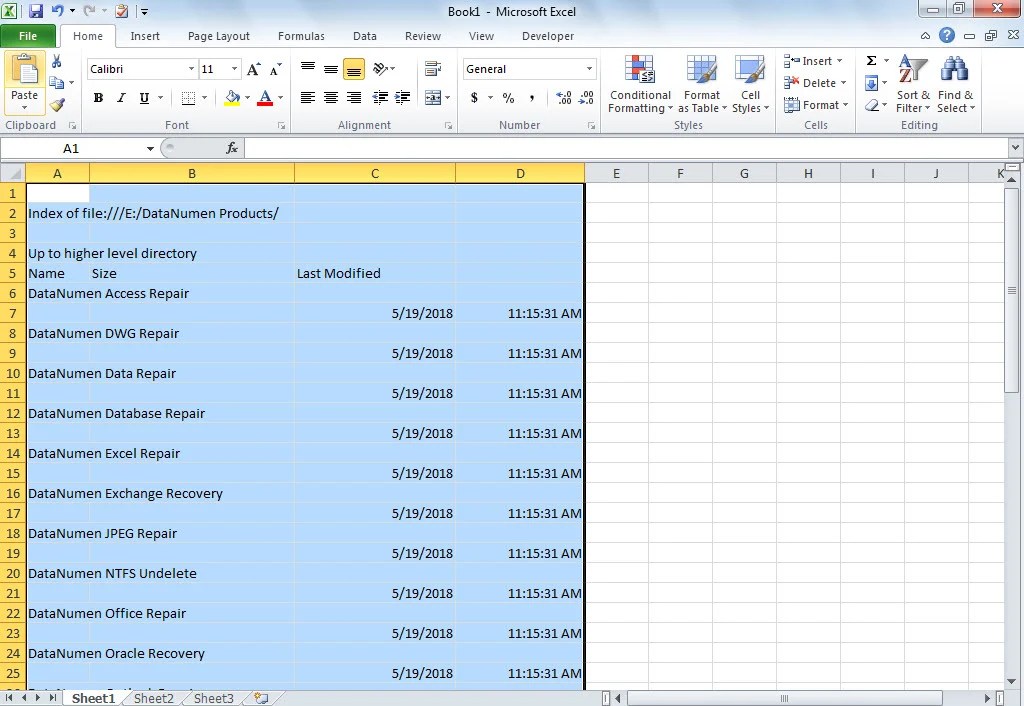List Excel Sheet Names: Quick and Easy Guide

Introduction to Managing Excel Workbooks
Excel, the robust spreadsheet software by Microsoft, has become an essential tool for businesses and individuals alike for its versatility in handling large datasets, performing intricate calculations, and presenting data effectively. One of the core features of Excel is the ability to manage multiple sheets within a single workbook. Knowing how to list Excel Sheet Names efficiently can significantly enhance your productivity and workflow management. This guide offers a step-by-step approach to quickly and easily navigate through this feature.
Importance of Listing Excel Sheet Names

Before delving into the methods of listing Excel Sheet Names, let's understand why this feature is crucial:
- Organization: Managing multiple sheets becomes simpler when you can quickly view all available sheets at a glance.
- Data Tracking: For datasets spread across various sheets, having a list helps in tracking data consistency and integrity.
- Reference: For creating macros or writing scripts, listing sheet names ensures you're referencing the correct sheets.
- Presentation: When presenting Excel data, having a list of sheet names can make your work appear more organized and professional.
Using Built-in Excel Functions

Excel provides several in-built functions that can list sheet names. Here's how:
Method 1: VBA Macros

VBA (Visual Basic for Applications) is a powerful scripting language built into Microsoft Office. Here's how to use it:
- Open the Excel workbook where you want to list the sheet names.
- Press
Alt + F11to open the VBA Editor. - Go to Insert and choose Module to insert a new module.
- Paste the following VBA code into the module window:
Sub ListSheets() Dim ws As Worksheet Dim i As Integer i = 1 For Each ws In ThisWorkbook.Worksheets Sheet1.Cells(i, 1).Value = ws.Name i = i + 1 Next ws End Sub - Close the VBA Editor and run the macro by selecting Developer > Macros > ListSheets > Run.
- Check the first sheet where you'll now find the list of all sheet names.
📝 Note: Remember to enable macros if they are not already enabled by navigating to File > Options > Trust Center > Trust Center Settings > Enable all macros.
Method 2: Using Excel Formulas

While VBA offers a robust solution, some users prefer formula-based methods. Here's one:
- Open the Excel workbook.
- In a blank cell, type:
=GET.WORKBOOK(1) - Press
Ctrl + Shift + Enterto use this as an array formula. This function will list all sheets in the workbook. - Use functions like
MIDandFINDto extract the sheet names from the text result.
Utilizing Third-Party Add-Ins

There are several add-ins available for Excel that can list sheet names with minimal effort:
- Kutools for Excel: This add-in provides a direct tool to list all sheets.
- ASAP Utilities: Another useful tool to manage and list Excel sheets.
- Power Query (now known as Get & Transform): While not an add-in, this Excel feature can also list sheets.
To use add-ins, ensure they are installed and enabled:
- Download and install the desired add-in.
- Enable the add-in from File > Options > Add-Ins > Manage (select Excel Add-ins) > Go.
- Use the tool or wizard provided by the add-in to list your sheets.
Advanced Techniques

For those interested in more advanced techniques, consider the following:
Power Query

Power Query, now part of Get & Transform, can list sheets from a workbook:
- Go to Data > Get Data > From File > From Workbook.
- Navigate to and select your workbook.
- In the Navigator window, you'll see all sheets listed on the left panel.
While this doesn't directly place the list into a cell, you can load the data into the query editor, modify the list, and then load it back into Excel.
Scripting with Python

If you're familiar with Python and openpyxl library, here's a snippet to list sheet names:
from openpyxl import load_workbook
workbook = load_workbook("your_excel_file.xlsx")
sheet_names = workbook.sheetnames
print("Sheet Names:")
for name in sheet_names:
print(name)
Key Takeaways

Listing Excel Sheet Names is essential for efficient workbook management, reference, and presentation. Whether you opt for built-in functions like VBA macros or advanced techniques like Power Query, the methods provided can simplify the process significantly. Remember:
- VBA macros offer a direct and quick solution for listing sheets.
- Excel formulas can provide a no-code alternative, albeit with more complexity.
- Third-party add-ins can enhance your Excel experience with specialized tools.
- For more advanced users, scripting languages like Python or utilizing features like Power Query open up additional possibilities.
The key to mastering Excel is understanding and leveraging its capabilities to fit your workflow. Now that you have these methods at your fingertips, go ahead and enhance your Excel experience by efficiently managing multiple sheets in your workbooks.
Can I list hidden sheets using these methods?

+
Yes, all the methods listed, including VBA macros, formula-based approaches, and tools like Power Query, will list hidden sheets as well. However, some add-ins might exclude hidden sheets unless specifically set up to include them.
What if I need to list sheet names from multiple workbooks?

+
For listing sheets from multiple workbooks, you would need to adapt the VBA macro to open each workbook, retrieve the sheet names, and then close it. You could also use a Python script with openpyxl to loop through all workbooks and compile a list of sheet names.
Are there any limitations to using Power Query?

+
Power Query has limitations concerning external files; for example, if your workbooks are password-protected or located on a network drive with restricted access, you might face issues retrieving the sheet names. However, these are manageable with the right setup and permissions.